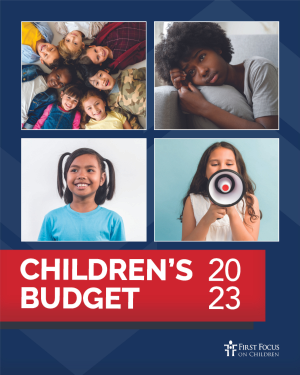As the COVID-19 emergency has receded, so has our nation’s commitment to children.
Children’s Budget 2023 finds that U.S. spending on children, both here and abroad, accounts for just 9.89% of the FY 2023 federal budget, a decrease of nearly 16% in real spending from the previous fiscal year. The share of spending on children also falls well shy of the record 11.97% children’s share reached in FY 2021 at the height of the public and economic health emergency. This 2 percentage point drop from historic investments in children during FY 2021 means spending on children in FY 2023 is nearly back to the same level seen in FY 2019 prior to the pandemic.
For more than 15 years, First Focus on Children has produced our annual Children’s Budget, an analysis of the funding — and therefore the value — that we as a nation place on our children. Pushed by the emergency of the COVID-19 pandemic, U.S. lawmakers finally began moving toward a fair share of federal spending for children. But as that emergency receded, so has our nation’s commitment to securing the health, safety, and well-being of our children at home and abroad.
Our children — and our country — now stand at a crossroads.

COVID-19 and its economic fallout affected every aspect of the lives of children, infringing on their health, education, economic security, safety, and well-being. The full extent of the consequences for children will not be known for years.
In Congressionally enacted legislation, lawmakers provided funding to expand eligibility for essential programs, such as Medicaid and the Children’s Health Insurance Program (CHIP). Children and families across this country benefited from improvements made to the Child Tax Credit and the Earned Income Tax Credit – with the Child Tax Credit expansions resulting in more than a 40% reduction in childhood poverty in this country. Furthermore, the federal government provided critical funding for child care, education, and Head Start centers to better support children and allow parents and caregivers to return to work. Leaders made investments to reduce child hunger and to expand homeless children and youth wraparound services to address the problems that arose from increased unemployment and school closures.
As a result, the share of federal domestic and international spending on children increased from a record low of 7.56% in FY2020 to 11.97% in FY 2021. Unfortunately, now that the pandemic is over, lawmakers seem to have lost the urgency around the needs of our children and our 2023 analysis reveals that the share of spending on children is headed back down.
Our kids stand at a crossroads. Our leaders have the power to help children achieve their greatest potential and follow their hopes and dreams. The alternative is to head down a path of austerity and underinvestment that fails our children.
We call on Congress and the Administration to choose the right course.
Watch the Children’s Budget Summit
Key Takeaways from Children’s Budget 2023
In FY 2021, investments in children drove child poverty in the U.S. to its lowest level in history, cutting it nearly in half. Unfortunately, that progress has been erased as policy improvements expired. In 2022, child poverty more than doubled to over 12%, the largest increase of poverty in all age groups between 2021 and 2022, according to the U.S. Census Bureau’s Supplemental Poverty Measure.
In four of the 11 areas analyzed, First Focus on Children found a notable decrease in the share of children’s spending between FY 2018 and FY 2023, indicating a lag between spending on kids and increases in the federal budget. For instance:
- Income Support: Income support for children declined more than 19% as a share of federal spending in FY 2023 compared to FY 2018, primarily as a result of the expiration of the expanded Child Tax Credit (CTC) in January 2022.
- Health Care: The share of federal spending on children’s health care declined nearly 10% in FY 2023 compared to FY 2018, including a nearly 16% decrease in real funding for the Children’s Health Insurance Program (CHIP), which covers roughly 9 million children.
- Housing: The share of federal spending on housing for children and families decreased by nearly 11% from FY 2018 to FY 2023. And despite skyrocketing rents, housing assistance for families makes up just 0.3% of the federal budget in FY 2023.
- Early Childhood: The share of federal spending on early childhood programs declined more than 16% between FY 2018 and FY 2023 and makes up just 0.4% of the federal budget in FY 2023.
Internationally, the United States historically has spent just a sliver of its budget on children and that trend continues in Children’s Budget 2023. Children and young people internationally receive a minimal share of foreign assistance funding: Only about 9 cents of every $1 of FY 2023 foreign assistance investments benefit children.
Children’s Budget 2023 analyzes the share of spending allocated to kids across more than 250 government programs in the federal budget. For the purposes of this study, First Focus on Children categorizes programs into 11 investment areas: Early Childhood, Education, Environmental Health, Health Care, Housing, Income Support, Justice and Child Protection, Nutrition, Safety, Training, and International.
First Focus on Children’s annual Children’s Budget is meant to offer U.S. leaders and lawmakers a comprehensive picture of where and how we spend our money on children, and what changes we must make to better prioritize them in federal budget and policy decisions.